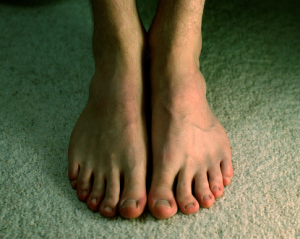Diabetic Amputations Are Totally Avoidable
 Diabetic foot ulcers are the most common cause of hospitalizations and lower extremity amputations in the United States. If left untreated, foot ulcers can lead to infection, gangrene and amputation.
Diabetic foot ulcers are the most common cause of hospitalizations and lower extremity amputations in the United States. If left untreated, foot ulcers can lead to infection, gangrene and amputation.
Just as Native-Americans, Latinos, and African-Americans have higher incidences of diabetes compared to whites, there are remarkable variations in amputation rates among certain ethnic groups. For example, Latinos and African-Americans have a two-fold higher risk of amputations compared to whites, while Pima Indians have a four-fold higher rate. Regrettably, South Texas reports twice the national amputation rate, and the rate in McAllen, Texas is three times higher than in Amarillo!
Certainly, access to adequate foot care plays a role in these disparities, but education about proper foot care is just as important.
Contrary to what many believe, amputation is not an inevitable complication of diabetes — but the result of modifiable risk factors. With a team approach to managing diabetes, including patient education and proper foot care, the incidence of amputations could be prevented or minimized by 44% to 85%. However, amputations continue to increase because many patients do not understand the importance of aggressively treating foot ulcers nor do they have access to preventive services for routine foot care or diabetes management.
People with diabetes should treat their feet with special care. By following some simple tips, diabetics can dramatically reduce their risk of amputation.
Here are some steps to prevent foot ulcers:
- Check your feet daily.
- Visit a podiatrist or family doctor once a year for foot care.
- If you have abnormalities to your feet, have your feet checked three times a year.
- Keep your blood glucose levels, cholesterol levels and blood pressure under control.
- Check your feet for cuts, blisters, or areas of irritation. If you have any of these see a podiatrist or family practice doctor.
- Wash and dry your feet, particularly between your toes.
- Protect your feet from extreme hot and cold temperatures.
- Avoid walking barefoot.
- Stop smoking
- Exercise
- Do not drink or drink in moderation.
When your toenails need trimming:
- Trim your nails straight across and only if you can see well.
- If you cannot see well or your nails are thick or yellowed, have a podiatrist trim them.
- Do not cut into the corners of your toes.
- Do not cut corns or calluses.
When you visit the doctor, ask her to:
- Look at your bare feet at each visit. As a reminder, remove your shoes and socks. Be proactive when it comes to your foot care!
- Check your feet for sense of feeling and your pulse at least once a year.
- Show you how to take care of your feet.
- Teach you about proper footwear to reduce the risk of injury that can lead to ulcer formation.
In order to get the right care, you must participate in your care. Remember, the more you know, the better your care!
References:
- http://www.amputee-coalition.org/inmotion/mar_apr_01/footcare.html
- http://www.southtexashealthsystem.com/Services-A-O/Diabetes-Management/MMC-Diabetes
- http://www.kevinmd.com/blog/2010/11/diabetes-leg-amputations-mcallen-texas.html
- http://web.caller.com/2001/february/26/today/localnew/18795.html
Jeff is a patient advocate, educator, scientist author of the book “Taking Control of Your Healthcare,” and, until his retirement, a professor at the University of Texas Health Science Center in San Antonio, Texas. For more information or to contact him, visit his website.
[Photo By tentwo.teneight]
